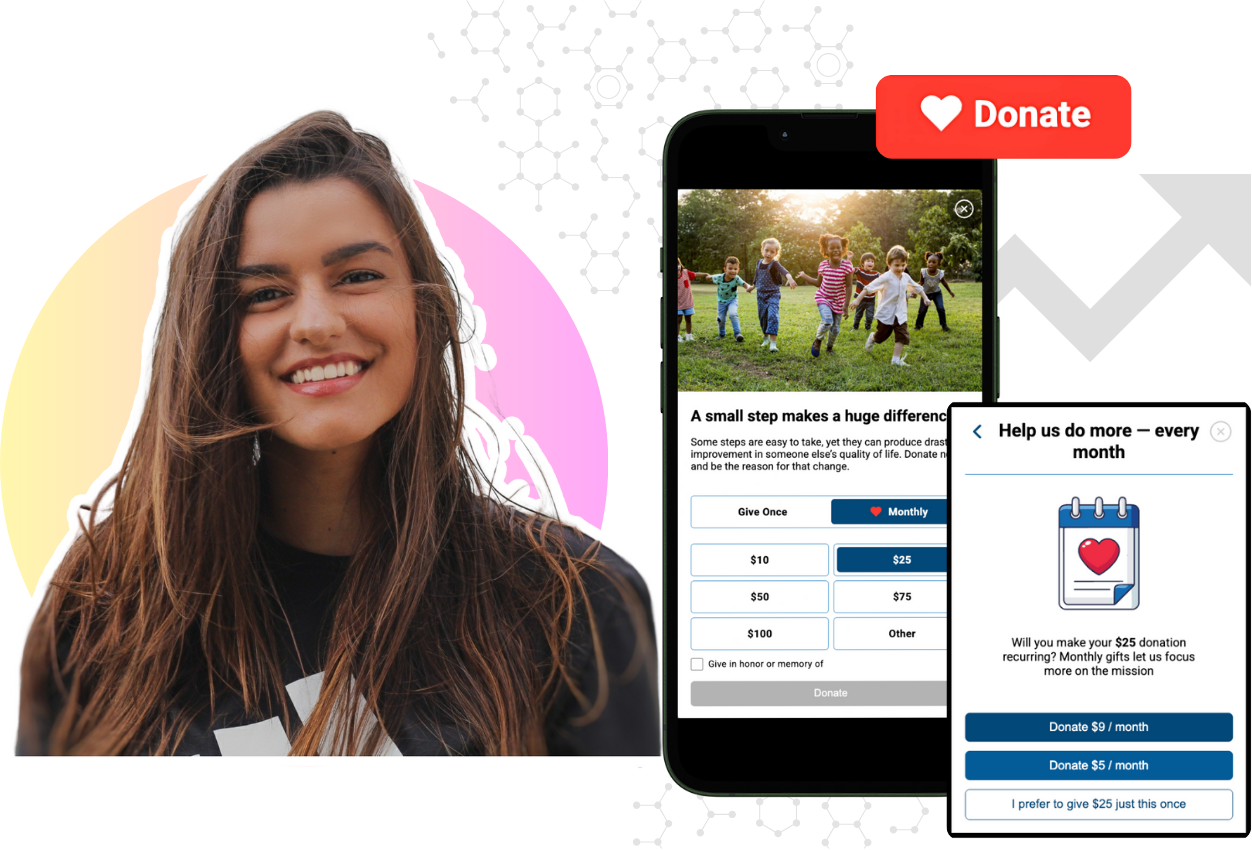Marketing Matching Gifts Ahead of Giving Tuesday
Marketing Matching Gifts Ahead of Giving Tuesday More than likely, your organization is already gearing up for a successful Giving Tuesday campaign...

Mobile-First Pop-Up Donation Form
Launch mobile-first pop-up forms in minutes, use built-in tools to capture more donations, and optimize the giving experience—no dev team required.
New to online donation pages for your nonprofit? Start here.
Donation page A/B testing - no science degree needed.
Keep your donation page loading fast - and drive higher conversions.

The 4 Types of Online Donation Experiences
89% of donors leave without giving. Learn how to use the right donation form to close the gap and boost conversions.

There is a marked decline in charitable giving among the general population. While this has been offset in dollar terms by steadily larger gifts from wealthy benefactors, the troubling fact remains: The share of American households that donate to charity has been steadily declining since the Great Recession of 2008.
More than a third of the decline in giving participation can be attributed to changes in income and wealth. In any event, giving rates have decreased among both younger and older Americans, according to an Indiana University Lilly Family School of Philanthropy report released last year (opens as a pdf). Moreover, both charitable trust and overall giving participation are shrinking at a greater rate among younger Americans than among older Americans.
There are a number of factors for the marginalization of giving, such as shifting demographics. New generations demand a different kind of interaction with the cause.
Gone are the days of baby boomers and Silent Generation writing checks to the nonprofit’s non-designated general operating funds. Younger generations require more personal and causal connections for their philanthropy.
This decline in broad participation has led to the marginalization of giving. Ironically enough, the most prominent example of how this shift is taking hold is Giving Tuesday, the well-intentioned global movement of giving back across communities following the rush of Black Friday and Cyber Monday.
While there’s nothing inherently wrong with focusing our attention on a day that revolves around giving, we should consider the following questions:
To answer these questions, we have to go deeper into why Giving Tuesday is simply ineffective for nonprofits and how organizations can best position themselves to encourage donors to give year-round.
There are social, economic and political forces that influence rates of giving and popular causes these days. But for all its good intentions, Giving Tuesday — which makes giving an exceptional event — underscores the retreat of charitable giving from something that was a regular ingredient of social life to something infrequent, a sporadic interruption of ordinary life.
Whatever the contributing factors are — and there are many — they don’t entirely displace the key role nonprofits are poised to play in mitigating if not reversing the decline in giving at a wider, societal level. With all the knowledge, tools and technologies available for fundraising today, nonprofits must ask themselves what more they could be doing or do better, to help ignite a culture of generosity.
At stake is an extraordinary opportunity to reposition giving in the minds of ordinary donors from an annual, one-day, exceptional occurrence to something they embrace as part of their day-to-day lives.
Turning every day into a giving day requires that nonprofits break a long-standing pattern in fundraising.
First, the nonprofit business model has been centered for too long now on meeting annual fundraising targets. Maintaining that posture has led nonprofits to view donors as proxies for transactions — at the expense of donor relationship-building. By reorienting themselves so that they are interacting with donors as real people — and reaching out to them throughout the year in consistent, personalized, relevant ways — nonprofits can leave each donor feeling acknowledged and recognized as an advocate and a catalyst for change.
The more progress nonprofits make in this direction — from being transaction-driven to relationship-minded — the more donors will come to see their advocacy as a regular, perennial feature of their lives. Giving becomes interwoven with other aspects of their lives that they deem valuable and worth sustaining.
Second, it’s essential to realize that, despite the demands and distractions that crowd our days, donors need very little coaxing to be reminded of the importance of a cause they care about. Donors feel deeply rewarded any time they have a chance to see the ways in which their gift is having a real impact on the cause they’re supporting.
By making a practice of showing donors, on a regular, consistent basis, how their contributions are actually solving a problem, nonprofits are rewarding their donors for their commitment. From there, it’s natural for a donor to reinforce that gratification by sharing it with family and friends, which, once again, makes giving part of their daily lives.
Unquestionably, the project of transitioning donors from treating giving as an anomaly they encounter once a year into something that is marbled into their ongoing lives, year-round, is a major undertaking. And nonprofits cannot bring this sea change about by themselves. There are several requirements that go into fostering a culture of generosity.
But it’s clear that recognizing donors for their gifts in personalized, genuine ways and providing ways for them to share about their giving and the good that it’s doing will go far indeed in making every day a giving day.

Marketing Matching Gifts Ahead of Giving Tuesday More than likely, your organization is already gearing up for a successful Giving Tuesday campaign...

The calendar has turned over another year, and that means new opportunities for giving and building relationships with your donors.

1 min read
2021 has flown by, and we are already in the month of November. Not only is this the busiest time of year for travel, family gatherings, and...